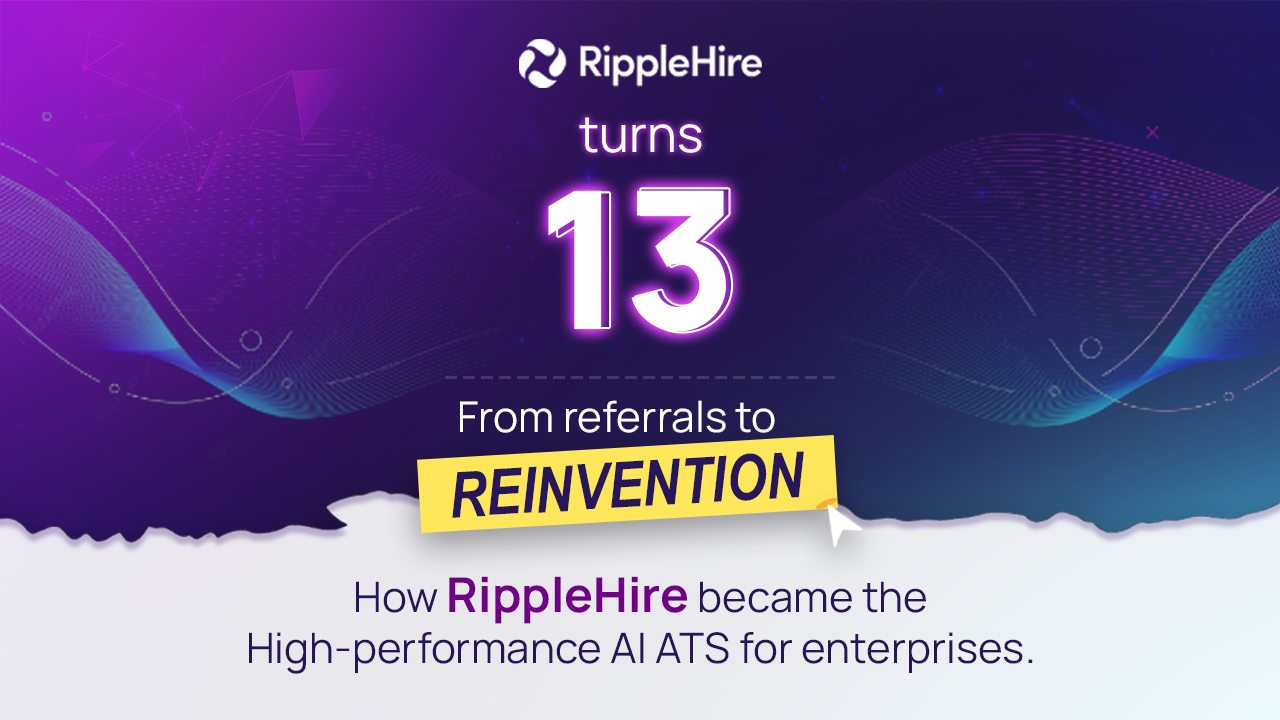How to Set Up Instant Feedback Loops During Hiring Drives
At most high-volume hiring drives, the biggest bottleneck isn’t sourcing candidates or even running interviews. It’s the gap between the interview and the actual feedback. Interviewers say, “I’ll upload it later,” recruiters chase them for days, and by the time the notes arrive, top candidates have already slipped away. Everyone knows this is a problem, but very few companies have cracked it.
That’s where instant feedback loops come in.
They transform the messy, after-the-fact scramble into a real-time system that captures decisions while the interaction is fresh. The result is speed, clarity, and candidates who walk away knowing exactly where they stand.
Let’s look at why feedback loops matter, what goes wrong without them, and how to set them up in a way that works for both recruiters and interviewers.
Why instant feedback loops matter
When enterprises scale hiring, speed is not optional. A feedback loop that works instantly means:
- Recruiters can build shortlists the same day.
- Interviewers don’t have to rely on memory days later.
- Candidates hear back quickly, reducing drop-offs.
It also brings consistency.
If every interviewer is rating communication or motivation on the same scale, comparisons are straightforward. No more debates about what “good” means. And for candidates, this structure feels fairer. Even those who don’t make it leave with a positive impression of the company.
Finally, there’s accountability. When results are logged in real time, everyone can see who has submitted and who hasn’t. That visibility removes the endless follow-ups that usually drag drives into chaos.
The challenges without feedback loops
Enterprises that still depend on paper notes or spreadsheets face the same issues, drive after drive. Feedback arrives late, sometimes incomplete, and often in formats that make consolidation painful. Comments like “seems okay” or “not a fit” don’t help recruiters decide.
The cost of these delays isn’t just operational. Candidates waiting for updates may accept offers elsewhere. Hiring managers get frustrated when they can’t see progress. Recruiters waste hours chasing interviewers rather than engaging talent. The net effect is slower closures and a weaker employer brand.
How to build effective feedback loops
Here are some practical ways to design loops that actually work on the ground.
Start with scorecards that are simple but sharp
Long evaluation forms kill adoption. A better approach is to define three or four role-specific attributes that really matter and create a short scorecard around them.
For example, in a customer support role, you might track:
- Spoken communication
- Patience under pressure
- Willingness to work shifts
A sales role, on the other hand, could emphasize persuasion and confidence. The point is to make it unambiguous. When interviewers know exactly what they’re rating, feedback is faster and more consistent.
Make capture frictionless
Even the best-designed scorecard won’t work if submitting it feels like extra work. Interviewers should be able to log their evaluation immediately after each interaction, ideally on their phone or laptop. A clean form, two minutes to fill, and it’s done.
This reduces the “I’ll do it later” problem that derails so many drives. It also ensures the feedback reflects what the interviewer actually observed, not what they half-remember hours later.
Brief interviewers before the drive
Interviewers often walk into hiring days after a full workweek, with little idea of what to expect. You should align recruiters and hiring managers before a hiring drive. A short huddle before the drive — walking them through the scorecard, reminding them why instant logging matters, and showing them how to record inputs — sets the tone.
This doesn’t need to be elaborate. Ten minutes is enough to align everyone and avoid confusion later.
Link feedback to candidate flow
A loop is strongest when it ties into the larger hiring process. That means a candidate should not move forward until the previous panel’s feedback is in. Recruiters should see status, evaluations, and next steps in one place.
This design makes feedback a natural checkpoint instead of an optional chore. Panels know that until they submit, the process doesn’t move — and that keeps everyone disciplined.
Close the loop with candidates
Feedback isn’t just for recruiters; it’s for candidates too. Instant capture should trigger timely communication.
- Shortlisted candidates: Inform them of the next steps before they leave the venue.
- Rejected candidates: Send polite closure messages the same day.
- Pending review cases: Share timelines transparently, e.g., “Expect an update in 48 hours.”
This transparency not only reduces candidate anxiety but also protects your employer brand by improving the candidate experience.
Whata good feedback loop looks like
Imagine a walk-in recruitment drive for customer service roles.
- At entry, candidates complete a short eligibility check.
- As they finish quick communication assessments, shortlisted candidates are assigned to interview panels.
- Interviewers evaluate using a 3-parameter scorecard: communication (40%), motivation (30%), and stability (30%).
- Each rating is logged digitally within minutes. If feedback is pending, the interviewer gets a reminder.
- Recruiters see a live dashboard showing candidate status and can instantly trigger SMS updates.
By the end of the day, hiring managers already have a shortlist ready. Candidates are informed of their status before they leave. Recruiters don’t spend a week chasing notes, and panels don’t argue later about what someone “meant” in their scribbled comments.
This is what an instant loop achieves: decisions captured in the flow of the drive, not after it.
The business impact of feedback loops
When feedback loops are done right, enterprises see a clear difference:
- Hiring cycles shorten because shortlists are built the same day.
- Recruiters stop spending energy chasing and redirect it toward candidate engagement.
- Drop-offs reduce because communication is faster and more transparent.
- Quality improves as evaluations are consistent and based on shared criteria.
And the softer impact matters too.
Candidates notice when a process runs smoothly. Interviewers appreciate not having to “catch up later.” Hiring managers gain confidence in the decisions being made.
Over time, these gains compound. Enterprises that master feedback loops turn hiring drives into reliable talent engines rather than stressful one-off events.
Making it easier with RippleHire
Spreadsheets, WhatsApp messages, and paper notes simply can’t keep up when hundreds of candidates and dozens of panels are involved.
RippleHire solves this by building instant feedback into the flow of the drive. Interviewers get simple, role-specific scorecards they can complete in minutes on their phone or laptop. Recruiters see a live dashboard of who has submitted feedback and which candidates are ready for next steps. Hiring managers get real-time visibility without chasing updates. And candidates benefit from faster, more transparent communication.
For enterprises, this means fewer delays, stronger accountability, and a consistent process that scales across locations. Instead of feedback being the bottleneck, it becomes the engine that keeps hiring drives moving at speed.
Want to see how this works in action? Book a demo with RippleHire today and experience how instant feedback loops can transform your next hiring drive into a smooth, data-driven process.
FAQs
Why are instant feedback loops important in hiring drives?
Instant feedback loops prevent delays that usually slow down high-volume hiring. When interviewers log inputs immediately, recruiters can build shortlists on the same day, and candidates receive timely updates. This reduces drop-offs, ensures fairness, and strengthens your employer brand. Without loops, notes pile up, and decision-making drags, creating frustration for both candidates and hiring managers.
How do instant feedback loops improve candidate experience?
Candidates often feel anxious waiting to hear back after interviews. With instant loops, outcomes can be communicated while they are still at the venue or shortly after. Even a quick closure message shows respect for their time. This transparency keeps them engaged, reduces repeated queries, and leaves them with a more positive impression of the company—even if they aren’t selected.
What are the biggest challenges without instant feedback?
Enterprises that rely on paper notes or delayed submissions face incomplete feedback, inconsistent evaluations, and long shortlisting cycles. Recruiters spend hours chasing interviewers, and hiring managers lose confidence in the process. The worst impact is on candidates, who often accept competing offers while waiting. Over time, this erodes the effectiveness of hiring drives and damages your reputation.
How can enterprises set up effective feedback loops?
Start by creating short, role-specific scorecards so interviewers know exactly what to evaluate. Make the process frictionless by enabling digital logging on phones or laptops. Brief interviewers before the drive, link feedback submission to candidate flow, and ensure recruiters see results in real time. Finally, close the loop by communicating outcomes quickly to candidates, which builds trust and reduces drop-offs.
What does a successful feedback loop look like in practice?
In a well-run drive, interviewers submit feedback digitally within minutes of meeting a candidate. Recruiters monitor a live dashboard showing evaluation status, panel load, and next steps. Shortlists are built in real time, and candidates are informed of outcomes before they leave. The day ends with clear data, ready pipelines, and fewer follow-ups—turning a chaotic event into a structured process.
How does technology support instant feedback loops?
While manual systems can work at a small scale, technology makes loops sustainable for large enterprises. A platform like RippleHire digitizes scorecards, captures real-time inputs, and shows recruiters instant progress. Interviewers spend less time on paperwork, recruiters gain visibility without chasing updates, and candidates benefit from quicker communication. The entire drive runs smoother, with decisions backed by timely, consistent data.















